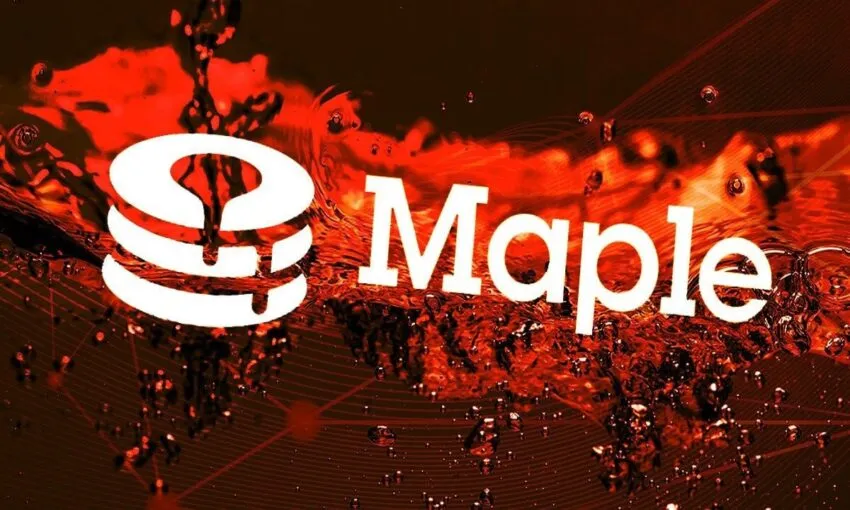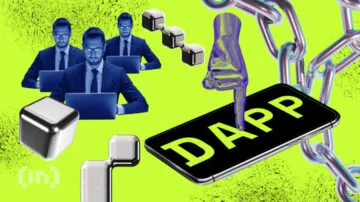Maple Finance is looking to shake up the digital financial sector for global lending. The protocol enables lending and borrowing in a way that is different from other DeFi projects through under-collateralization. The team says that through it, institutional borrowers can access funds more efficiently, and lenders can guarantee a decent yield for their efforts. In this extensive guide, we will cover how Maple Finance accomplishes this ambitious task.
KEY TAKEAWAYS
► Maple Finance is a decentralized lending platform that creates under-collateralized loans for institutional borrowers.
► The platform operates through a network of lenders, institutional borrowers, pool delegates, and stakers, each playing a distinct role in the lending process.
► Maple Finance emphasizes trust and reputation by thoroughly vetting borrowers, allowing for more safety without the need for overcollateralization.
► The native MPL token is important to the platform’s governance, staking, and reward systems, because it incentivizes participation and ensures the protocol’s sustainability.
What is Maple Finance?

The team behind Maple Finance believes that traditional lending systems and even decentralized finance (DeFi) can be disrupted and changed for the better. This is the reason why the project is trying to improve uncollateralized lending.
While similar protocols such as Aave and Compound have achieved success, they’ve also received their share of criticism. In their bid to ensure the projects’ solvency, they have also pushed for over-collateralization.
This is a situation in which the value of the collateral is larger than the loan value itself. Maple Finance argues that while this reduces the risk of the loan, it stops economic actors from accessing the funds that would help them develop their ideas.
Among its benefits is the fact that lenders can also depend on stable yields. Furthermore, the lenders also receive the platform’s native token, MPL, on top of the interest that they accrue. In this way, the team behind Maple argues that they allow borrowers to access the capital market, all while eliminating third parties.
How does Maple Finance work?
Maple Finance functions on the Ethereum and Solana blockchains. Like other digital finance projects, it requires and benefits from the participation of the general public. However, unlike traditional DeFi systems, its lending and borrowing focuses on institutional lenders and corporate borrowers.
The main economic actors in this system are the institutional borrowers, the lenders, the pool delegates, and the stakers. Let’s look at each of their roles.
| Role | Description |
|---|---|
| Institutional borrowers | Receive their vetting from the platform itself. They include hedge funds, market makers, or crypto exchanges. They take advantage of the aggregated financial resources with all of the financial activity recorded on-chain. In exchange for the loans, the borrowers will pay an “establishment fee.” This goes towards the pool delegates and the project’s DAO, which controls the treasury funds. |
| Pool delegates | Responsible for checking up on the borrowers’ reputation and potential to pay back their loans. The delegates themselves get picked by the Maple Finance team. The information acquired by the delegates directly influences the conditions of each loan. The funds from the loans arrive from designated liquidity pools. |
| Lenders | Get the opportunity to receive a fixed yield when providing the funds administered by pool delegates. Each lender will deposit funds into a specific liquidity pool. Besides the interest rate, they may also receive MPL crypto incentives. |
| Stakers | Provide “loss capital.” Essentially, they stake Balancer Pool Tokens (BPT) tokens in order to cover losses in the event of a default. Stakers take upon themselves much of the loan risk. For their effort, they receive rewards distributed to them from the loan’s yield, as well as MPL staking rewards. |
What makes Maple Finance unique?

What makes Maple Finance different than most protocols is the way it addresses liquidity provision. Everything starts with the pool delegates’ mission.
They are responsible for the functioning of the lending protocol. This is why they undergo a difficult selection period, Maple’s developers claim. Once whitelisted, the delegates must provide a stake cover of at least $100,000.
Furthermore, the lenders and the borrowers must also review the delegate’s profile and sign off on it. They can also add additional liquidity cover when needed.
Similarly, Maple Finance must verify borrowers beforehand when signing up for the platform. Pool delegates verify their information. Furthermore, they are subject to a strict underwriting process. This determines their solvency. Once approved, the loan requests sent out by the borrowers appear on-chain and are visible to the borrowers.
To eliminate some issues related to cost and time, the protocol embraces the use of smart contracts. This means that it’s simple for credit experts to build businesses using the protocol and for well-respected borrowers to access funds without much hassle.
The protocol’s incentive system utilizes the platform’s native token, MPL. The token is essential for on-chain operations, as well as for its use in the governance process. It also helps ensure the lending pools through the process of staking.
The Maple Finance is a multi-chain project that runs on the Ethereum and Solana networks. It has received a good deal of attention since its release in May 2021. According to official data, over $1 billion in loans were secured over the first ten-month period of the project.
Benefits of Maple Finance
The rise of the crypto space has meant that more and more institutional actors are looking for funding. Maple Finance argues that the industry’s current shape cuts many of these institutions from financing, which could be highly beneficial for the entire crypto ecosystem.
The platform facilitates financial inclusion on-chain for businesses across the financial industry, such as real estate, insurance, credit cards, etc. Maple says that its objective is to create a $100 billion company. This would make it one of the largest crypto capital networks. Besides all of this, there is still great potential for growth.
The Institute of International Finance published a report claiming that global debt had reached a value of over $300 trillion. The majority of this comes from under-collateralized loans. However, the vast majority of blockchain loans endorse over-collateralization.
How to use Maple Finance?

As mentioned earlier, there are many ways to take part in the Maple Finance ecosystem. There is an excellent amount of interconnectivity between the roles of the various actors using the protocol. This means that whether you are lending funds or simply staking, the evolution of Maple can be profitable for you.
If you are looking to become a lender, Maple Finance will provide you with a stable yield from carefully vetted borrowers. You need to deposit funds into a pool; in exchange, you will earn interest based on the pool’s liquidity asset. The pool delegate will determine the conditions of the loan and the value of the yield. Additionally, as a lender, you can earn MPL from liquidity mining.
You may also opt to provide pool cover. This helps the entire protocol create a financial buffer and mitigate loan risks. In the event of a default, the pool cover upsets the losses. Those who choose this option earn MPL rewards.
Users can also stake MPL. The process involves depositing directly into the platform through the MPL-compatible wallets. Maple plans to use 50% of protocol revenue to purchase MPL back from the market. The distribution of this crypto to stakers acts as a reward for their efforts.
Crypto-enthusiasts may also apply to become Pool Delegates. They are chosen based on their competence and reputation. For their efforts, they receive two types of rewards:
- They get a portion of the interest accrued from borrowers.
- Part of the establishment fee or each loan is distributed to them.
Last but perhaps most importantly, borrowers can take out on-chain loans using the protocol. Prior to accessing the funds, their capacity to pay back the loan is carefully evaluated.
What is Maple (MPL)?

MPL is the native token of Maple Finance. It is an ERC-20 token but inherits ERC-2222 token standards when it comes to profit distribution. It plays a fundamental role in regular operations regarding loans and staking. The governance process also makes use of MPL.
Tokenomics
MPL has a finite amount of 10,000,000 tokens. Out of this, the distribution of 500,000 involved a Balancer liquidity Bootstrapping tool that lasted 72 hours.
One of the most significant portions of the existing MPL, 26%, is in the ownership of seed investors. Next, The Maple Treasury accounts for 14% of the total supply. The sale at public auction makes up 5%. Finally, the liquidity mining process accounts for 30%, while the developers and other advisers control 25% of MPL.
It is worth mentioning Maple’s xMPL. Users can stake MPL in exchange for xMPL. They will also receive part of the revenue generated from the protocol together with other utilities.
Will Maple revolutionize the global financial system?
Maple Finance sees a problem in the general desire for over-collateralization. It believes that this leaves important economic actors unable to benefit from funds. Instead, it focuses on Pool Delegates to mitigate loans, and this under-collateralization ideally speeds up loans, gets funds to the right people, and provides lenders with a hefty yield.
If all of these pieces are in place, Maple believes that they can be used across the board when it comes to the financial sector, from real estate to the credit card industry. Is there more to follow, and can regular crypto users profit from investing in MPL? Only time will tell.
Frequently asked questions
What is Maple Finance?
How does Maple Finance make money?
Is Maple a good investment?
Where can I buy Maple crypto?
Disclaimer
In line with the Trust Project guidelines, the educational content on this website is offered in good faith and for general information purposes only. BeInCrypto prioritizes providing high-quality information, taking the time to research and create informative content for readers. While partners may reward the company with commissions for placements in articles, these commissions do not influence the unbiased, honest, and helpful content creation process. Any action taken by the reader based on this information is strictly at their own risk. Please note that our Terms and Conditions, Privacy Policy, and Disclaimers have been updated.




